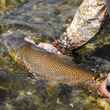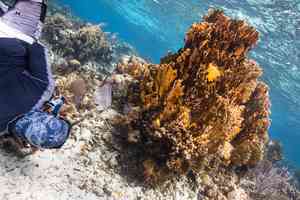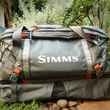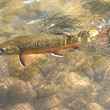Autumn is one of the most beautiful times to be on the water, especially when fall foliage is at its peak. However, this time of year also creates some of the most challenging fishing conditions of the year, including low water. While there is no shortage of recommendations on how to tackle autumn conditions, here are a few of my favorite tips for dealing with low flows and other challenges common during the fall days on the water.
Movement Spooks Fish More Than Color
Low and clear water is the norm during much of autumn and especially during the latter parts of the season. Be prepared to deal with reduced flows and spooky fish. Even the best camouflage gear will not hide you from the fish if you lack stalking skills. The late Gary LaFontaine said it best, “movement spooks fish more than color.” In other words, regardless of your attire, if you make excessive movements when wading into position or while making a cast, you’re going to spook fish.
To be clear, I still recommend wearing drab or camo clothing when you’re on the water as they will increase your ability to remain hidden from your quarry, but your main focus should be on improving your stalking skills. While camo helps, I have no issues wearing bright orange for safety during hunting season, as I’ve had excellent fishing success while wearing bright orange hats and vests during hunting season, thanks to careful movements and deliberate stalking.
Use a Lighter Line
Choosing the right line weight or line color, which is more vital to stealth? This is a highly debated question but, in my opinion, line weight is more important than color. While a brightly colored line can certainly spook fish, in my experience, a heavy line landing on the water will scatter even more fish—even if skillfully presented. This is why I rarely use a 5- or 6-weight fly line during low flows. Even if the line is drab in color, the mass of such a line landing on the water is likely to spook fish. Instead, I’ll use a 3- or 4-weight during low water conditions.
Lengthen Your Leader, The Easy Way
Creating greater distance between your fly line and your fly helps spook fewer fish. During autumn and other times of low flow, I often use 12-20’ leaders when fishing dry flies or light dry-dropper rigs.

Years ago, Tom Rosenbauer passed along a tip for lengthening leaders that has helped me keep my leader formulas simple ever since. Rather than lengthening or increasing the number of tapered sections in your leader, simply add heavy nylon material to your leader’s butt section to increase its overall length. For example, I will add 5’ of 40lb Maxima Chameleon to a standard 12’ 5X Leader to create a 17’ 5X leader. Instead of having to carry multiple leaders, I may carry several 7.5’, 9.5’ and 12’ 5X Leaders and simply add butt section material when I want to lengthen my leader.
It’s not always the perfect solution for situations that call for extremely delicate presentations but, more often than not, it works well enough.
Go Dry-Dropper instead of Euro During Low Flows
While Euro tactics can catch fish in all conditions, they limit the distance you can cast while keeping line off the water. When dealing with low water, distance is often your friend. Euro nymph rigs excel within a range of 30’, but when the conditions call for presentations beyond that distance, I opt for a dry-dropper nymph rig.

I also opt for a dry-dropper rig over one which uses a bobber or strike indicator. Not only does the dry fly look more natural, it creates less impact when landing on the water. If you absolutely must use an indicator, avoid hard-sided indicators (e.g. Thingamabobbers, AirLocks, etc) and opt for soft materials such as wool, as the impact of hard plastics and other rigid materials on the surface will send fish running for cover.
Use a Downstream Presentation
Another reason I prefer the dry-dropper approach during autumn low flows is that it allows me to present nymphs downstream to the fish. Compared to Euro tactics where more presentations are made upstream, dry-dropper tactics allow the angler to cast downstream to the fish. Not only will this result in the fish seeing your fly before your line and leader, any impact on the water will occur well upstream from the first as opposed to directly over its head.
Using this approach, you can spot your target from a safe distance, identify the current seam that flows to it, make a short cast into that seam, and feed slack into the drift as the fly travels the long route to its intended destination.
Create Less Disturbance When Picking Line Off the Water
A sunken fly line or leader can create a loud disturbance when an angler picks line off the water to re-cast or set the hook, as the line and leader break the surface tension of the water. One simple solution to this problem is applying a floatant grease to your fly line’s tip section as well as the butt section of your leader. I prefer grease floatants over gel types as they tend to stay on to the line and leader for a longer time. Regular application of a grease floatant will keep your rig floating high on the surface, allowing you to quietly peel, rather than rip, your fly line and leader off the water.






























Comments
Kerry replied on Permalink
Appreciate the very useful tips. Well done!
Pages